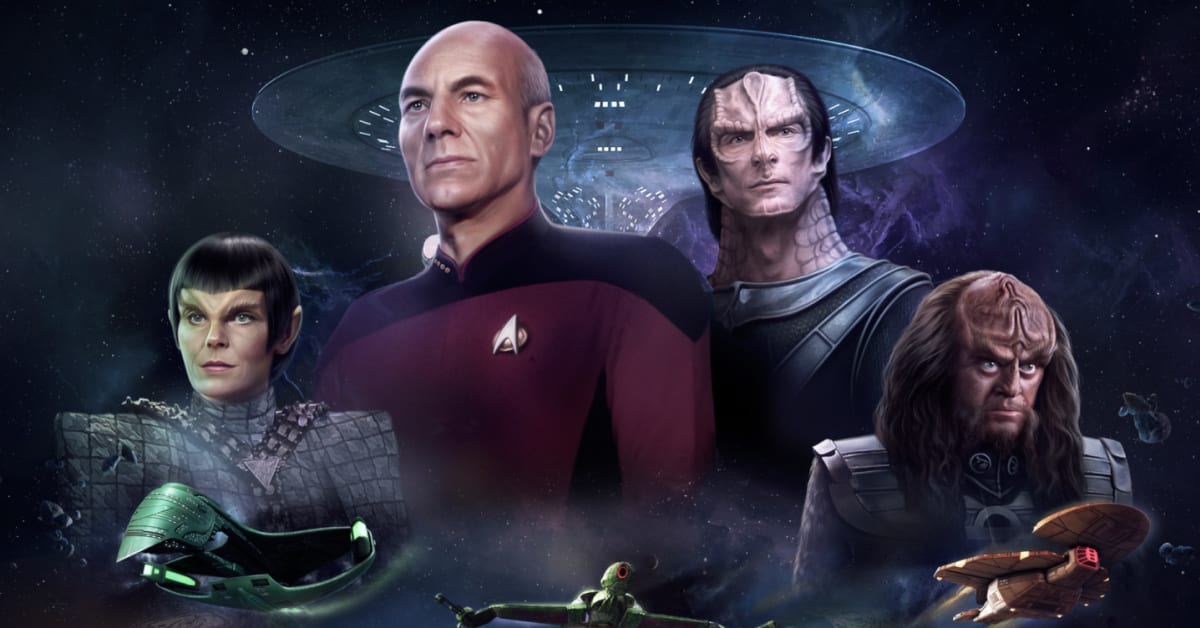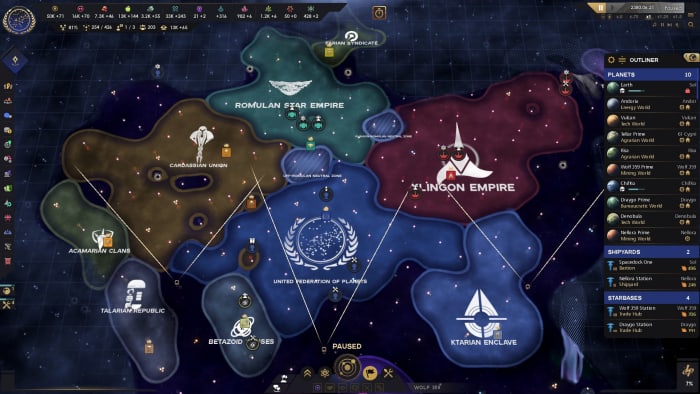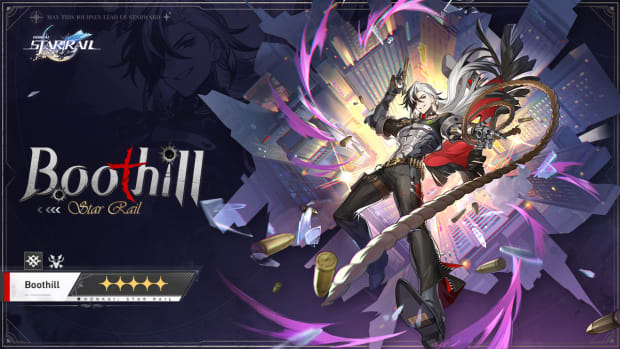
Star Trek: Infinite review – to go where others have been before
Upcoming Star Trek: Infinite, a 4X grand strategy game developed by Nimble Giant Entertainment and published by Paradox Interactive, has been a weird game to review, because it felt like I’ve spent hundreds of hours in it already. And that’s because I kind of have.
Star Trek: Infinite is based on Paradox’s own 4X grand strategy title Stellaris and is essentially an official Star Trek mod for the game sold for $30 USD. When I say “based on,” I mean that it uses the same engine, codebase, assets, and gameplay systems. That’s not a bad idea. If there is a game out there that is the perfect foundation for a Star Trek title, it’s Stellaris with its ideas on space exploration and discovery, interstellar diplomacy and economy, and galactic warfare.
You still send out research ships to chart new star systems, discover resources, and complete events, claim them by building bases, grow your colonies by placing buildings and districts, and so forth. War, spying, diplomacy, managing your empire – it works the same way.
Infinite took that fantastic foundation and provided some streamlining, doing away with the systems that don’t quite fit the setting as well and adding bits and pieces here and there to deliver a more focused experience. A lot of those added systems feel almost like they’re loaned from Paradox’s Hearts of Iron series, adding another title from the family into the mix – all factions have their own HoI-style mission tree, for example, giving you some direction on your playthrough. Another feature with some HoI-resemblance is Galactic Tension. Hostile actions between powers destabilize the entire interstellar political system, while cordial actions ease tensions. The higher tension is, the easier it is for everyone to slip into all-out war – it’s like a domino effect as everything spirals out of control.



A cool feature grabbed right from the setting is the existence of neutral zones that can be created as a buffer space between empires at the end of a war. The Federation-Romulan neutral zone is there right from the beginning, but more can be added throughout a campaign – and, of course, you can violate those zones as well, if a war is what you’re after.
These are all solid systems that make sense for the setting as well as the game and are pretty fun to engage with, especially from different perspectives.
You can play Star Trek: Infinite as the Federation, Klingons, Romulans, or Cardassians, which all have their own play styles and special mechanics. As the Federation, you’re naturally suited for a more diplomatic approach, so I eased tensions wherever I could playing as them – I’m practically besties with the Klingons and have clandestinely supported the Romulans in their war against the Cardassians, since the latter don’t like me at all and I caught them spying on me. Naughty. In terms of expansion, the Federation is great at integrating new members peacefully. You can get them to give you diplomatic missions, which on completion boost your relations.
The Federation’s mission tree in large part revolves around the iconic USS Enterprise. You first unlock the ship and then collect additional crew members like Data and Worf by completing the associated mission nodes. I’m not what you’d call a Trekkie, but my dad’s one and so I’ve got a fair share of knowledge and liking of the universe, so it’s pretty cool to have people like Data and Spock as your chief scientists or have your fleets commanded by Riker and Sissko. Enterprise is both a warship and a science ship, enabling you to do those far-away missions the vessel is known for, no matter if they are military, scientific, or diplomatic. You can also get ships like the Fearless as time progresses. Anomaly events, technologies, ships, and buildings have all been Trekkie-fied, as you’d expect.
As I mentioned, all four factions have different mechanics: The Klingons are divided into houses that compete with each other, leading to stability problems, and their military focus allows them to take over minor powers by instigating coups on their planets. The Romulans are great spies and like the Federation can assimilate minor powers without war. The ruthless Cardassians are slavers, who occupy minor powers by force and are driven to expansive behavior because their slave count drops continuously. Victory is either achieved by being more powerful than any other state in 2646, when the game ends, or by integrating a certain amount of minor powers into your empire before the others do.

It's pretty cool to get to recruit characters like Spock and use them in positions.
Paradox Interactive
A campaign of Star Trek: Infinite will be more narratively structured than your average Stellaris run. Things start with the Khitomer Massacre in the year 2345 and then generally progress as franchise fans know them to do: You’ll find the Borg and can play through the event chain that transforms Picard into Locutus, for example. In that sense, Star Trek: Infinite is top tier – if you are a fan of the universe, this game is the perfect playground for you.
However, I don’t think it goes far enough in some places to distinguish itself from Stellaris. Any first contact, for example, feels like it should be a much bigger and more involved deal in a Star Trek game, but it’s still just about sending an Ambassador and waiting for some time. That’s kind of underwhelming and adds to that feeling of “been there, done that” you get as a Stellaris player. There is also – necessarily, due to the setting – much less overall variety. This’ll sound like heresy if you’re a fan, but Star Trek’s aliens are pretty boring. They’re all just humans with some facial textures added here and there. And while you have four fairly fleshed out factions, that’s a drop in the bucket compared to the infinite possibilities you have in Stellaris.
That’s another weird thing about this game: It’s not just that it’s 85% Stellaris already, if you just bought Stellaris you could play some great Star Trek mods in it for free – mods, I’d wager, that’ll soon use the assets from this title as well. So, what does Star Trek: Infinite bring to the table?
I’d honestly say that its smaller scope and focus is probably its biggest advantage. As much as I enjoy mods that provide more depth and respect the work put into these free products, some of them just go too far in adding subsystems in the name of authenticity or complexity. They forget that games are supposed to be fun, not just simulations of a universe that must be as realistic and convoluted as possible. That’s a point that Star Trek: Infinite doesn’t forget. It’s a 4X grand strategy game that’s pretty easy to pick up by Paradox standards and comes with a passionate Star Trek flavor – and I don’t think it aspires to be more than that.
Again, that’s completely fine. But even under this premise, there is surprisingly little that’s new about Star Trek: Infinite, and I can’t help but be disappointed by that. I’d have loved to see some more outside-the-Stellaris-box thinking to really help the game fly with its own warp drives.
On a technical level, Star Trek: Infinite has been a stable experience for me, though not without some rather annoying hiccups that I’d describe as typical Paradox launch shenanigans. Some missions were bugged and could only be completed by reloading to previous points in the game due to the wrong conditions being given, for example. Nothing in terms of visual glitches or crashes on my end, though.
If you’re a 4X grand strategy fan first and a Star Trek fan second, I’d never recommend you this over Stellaris, but if you’re a huge Trekkie and just happen to also like video games, Star Trek: Infinite will beam boatloads of fun right into your living room.
Score: 7/10
- Visuals: 7/10
- Sound: 7/10
- Gameplay: 8/10
- Technical: 7/10
Version tested: PC.






